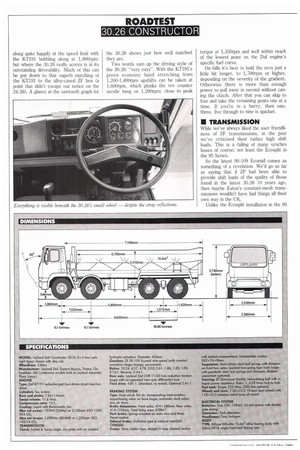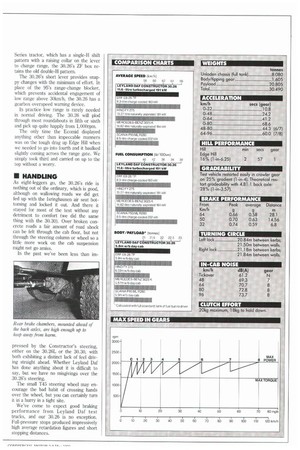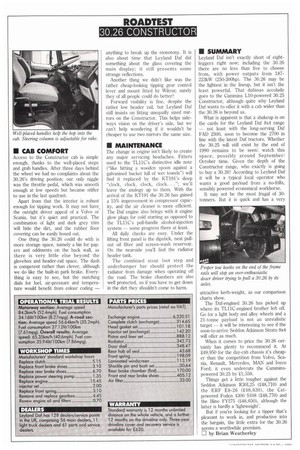ROADTEST
Page 68

Page 70

Page 71

Page 72

If you've noticed an error in this article please click here to report it so we can fix it.
30.26 CONSTRUCTOR
Many tipper operators still appreciate no-frills practicality at a sensible price. Leyland Daf's 30.26 Constructor eightlegger is a good example of the breed, enlivened by a superbly matched driveline.
• Despite being bombarded with adverts telling them to put more power under their right foot, plenty of tippermen are resisting the temptation to rush out and buy an eight-legger with a fire-breathing engine. But for how long?
Back in 1984 eight-wheelers with more than 205kw (275hp) on tap accounted for a mere 2% of the four-axle rigid market. Today, over half of all the 8x4s sold in the UK come into that sector, so somebody out there must like them. But the major players in the market don't appear to be in any hurry to drop their moderately powered lighter models, which will always find a home with those hauliers more concerned with fuel economy and payload than blistering performance.
Leyland Dafs 'lightweight' 30.26 Constructor stands firmly in this camp. Distinguishable from other Constructor 8x4 models by its narrow C51L (Freighter) cab it's very much the 'cooking' eightlegger of the Constructor family.
When Commercial Motor first tested the 30.26L (as it was then called) two years ago, we were struck by its nononsense performance and a payload nudging 21 tonnes. At the time its undoubted virtues were rather overshadowed by the question as to what would happen to it when production of the old Leyland TL11C engine finally ceased at the end of 1988. Would it get a Dal engine, or maybe a Cummins C Series?
Leyland Daf ended the speculation by the middle of last year. Out went the 30.26L with the TL11C, Spicer 10-speed crash box and a Dana Spicer clutch: in came the 30.26 (no L) with the 11.6-litre Daf KT191 turbo-diesel, ZF Ecomid nine speed synchromesh box and a Fichtel and Sachs clutch.
Apart from its new heart, the basic Constructor has not changed much. The frame is stronger; the brakes boast automatic slack adjusters and an air dryer as well. The air tanks have been moved inside the frame rails and a revised air intake provides cleaner air to the turbine. But look closely and you'll still find some old friends, like the venerable Albion twospring rear bogie.
Regular readers could be forgiven for a touch of déjà vu over this week's test. The 30.26's driveline is shared by its 6x4 Constructor 24.26 stablemate which we recently put through its paces around our tipper test route (CM 22-28 February).
• PERFORMANCE
The KTI9lia combination worked well in the 24.26, but we were keen to see if it could still do the business with another six tonnes on board. Judging by the 30.26's results, it can. Around our 2601un route the Daf-powered 30.26 showed itself to be every bit as good as its smaller brother and noticeably better than its predecessor into the bargain.
Not only is the Dutch-engined 30.26 less thirsty than the old TL11C-engined 30.26L, but it's also quicker off the mark. Its overall consumption of 35.941it/100km (7.86mpg), and average speed of 65.35km/h make it a strong contender in its class. The most economical eightlegger we've tested to date is the more powerful and heavier, Scania P93ML (CM 26 April-1 May 1989), which turned in an excellent 31.781it/100km (8.89mpg) but at a noticeably slower average of 61km/h.
The tipper that really caught our eye lately is the ERF E8, powered by the high-revving, charge-cooled Cummins C Series engine developing 183kW (245hp), close to the 30.26's 191kW (256hp). The E8-26's 34.41it/100km (8.21mpg) and 65.7km/h helped it walk away with this year's Testers Choice for multi-wheelers.
The ERF beats the 30.26 Constructor on fuel economy, but only just on performance. In fact, when it comes to outright acceleration, between 0-80Iun/h the 30.26 can outrun most of the 8x4s we've tested, including some higher-powered rivals. Notable exceptions are the Volvo FL10 and the Constructor 30.30 with the Perkins 800 Eagle engine.
On the motorway the 30.26 trundles • along quite happily at the speed limit with the KT191 bubbling along at 1,800rpm; but where the 30.26 really scores is in its outstanding driveability. Much of this can be put down to that superb matching of the 1(1191 to the alloy-cased ZF box (a point that didn't escape our notice on the 24.26). A glance at the sawtooth graph for the 30.26 shows just how well matched they are.
Two words sum up the driving style of the 30.26: "very easy". With the 1(1191's green economy band stretching from 1,200-1,800rpm upshifts can be taken at 1,600rpm, which plonks the rev counter needle bang on 1,200rpm; close to peak torque at 1,350rpm and well within reach of the lowest point on the Daf engine's specific fuel curve.
On hills it's best to hold the revs just a little bit longer, to 1,700rpm or higher, depending on the severity of the gradient. Otherwise there is more than enough power to pull away in second without caning the clutch. After that you can skip to four and take the remaining gears one at a time. If you're in a hurry, then one, three, five through to nine is quicker.
• TRANSMISSION
While we've always liked the user friendliness of ZF transmissions, in the past we've criticised their rather high shift loads. This is a failing of many synchro boxes of course; not least the Ecosplit in the 95 Series.
So the latest 9S-109 Ecomid comes as something of a revelation. We'd go as far as saying that if ZF had been able to provide shift loads of the quality of those found in the latest 30.26 10 years ago, then maybe Eaton's constant-mesh transmissions wouldn't have had things all their own way in the UK.
Unlike the Ecosplit installation in the 95 Series tractor, which has a single-H shift pattern with a raising collar on the lever to change range, the 30.26's ZF box retains the old double-H pattern.
The 30.26's short lever provides snappy changes with the minimum of effort. In place of the 95's range-change blocker, which prevents accidental engagement of low range above 30kmih, the 30.26 has a gearbox overspeed warning device.
In practice low range is rarely needed in normal driving. The 30.26 will plod through most roundabouts in fifth or sixth and pick up quite happily from 1,000rpm.
The only time the Ecomid displayed anything other than impeccable manners was on the tough drag up Edge Hill when we needed to go into fourth and it baulked slightly coming across the range gate. We simply took third and carried on up to the top without a worry.
• HANDLING
As eight-leggers go, the 30.26's ride is nothing out of the ordinary, which is good, although on wallowing roads we did get fed up with the lsringhausen air seat bottoming and locked it out. And there it stayed for most of the test without any detriment to comfort (we did the same thing with the 30.30). Over broken concrete roads a fair amount of road shock can be felt through the cab floor, but not through the steering column or wheel so a little more work on the cab suspension might not go amiss.
In the past we've been less than im pressed by the Constructor's steering, either on the 30.26L or the 30.30, with both exhibiting a distinct lack of feel driving straight ahead. Whether Leyland Daf has done anything about it is difficult to say, but we have no misgivings over the 30.26's steering.
The small T45 steering wheel may encourage the bad habit of crossing hands over the wheel, but you can certainly turn it in a hurry in a tight site.
We've come to expect good braking performance from Leyland Daf test trucks, and our 30.26 is no exception. Full-pressure stops produced impressively high average retardation figures and short stopping distances.
• CAB COMFORT
Access to the Constructor cab is simple enough, thanks to the well-placed steps and grab handles. After three days behind the wheel we had no complaints about the 30.26's driving position; our only niggle was the throttle pedal, which was smooth enough at low speeds but became stiffer to use in the last quadrant.
Apart from that the interior is robust enough for tipping work. It may not have, the outright driver appeal of a Volvo or Scania, but it's quiet and practical. The combination of light and dark grey trim will hide the dirt, and the rubber floor covering can be easily hosed out.
One thing the 30.26 could do with is more storage space, namely a bin for papers and oddments on the back wall, as there is very little else beyond the glovebox and header-rail space. The dash is competent rather than clever, although we do like the built-in park brake. Everything is easy to see, but the matching dials for fuel, air-pressure and temperature would benefit from colour coding anything to break up the monotony. It is also about time that Leyland Daf did something about the glass covering the main display; it still presents some strange reflections.
Another thing we didn't like was the rather cheap-looking tipping gear control lever and mount fitted by Wilcox; surely they of all people could do better?
Forward visibility is fine, despite the rather low header rail, but Leyland Daf still insists on fitting unequally sized mirrors on the Constructor. This helps sideways vision on the driver's side, but we can't help wondering if it wouldn't be cheaper to use two mirrors the same size.
• MAINTENANCE
The change in engine isn't likely to create any major servicing headaches, Fitters used to the TL11C's distinctive idle note ("like hitting a wooden spoon against a galvanised bucket full of wet towels") will find it replaced by the KT191's deep 'clock, clock, clock, clock. . ."; we'll leave the analogy up to them. With the arrival of the KT191 the 30.26 has gained a 15% improvement in compressor capacity, and the air cleaner is more efficient. The Daf engine also brings with it engine glow plugs for cold starting as opposed to the TL11C's pull-handle alcohol-injection system some progress there at least.
All daily checks are easy. Under the lifting front panel is the dipstick, neat pullout oil filter and screen-wash reservoir. On the nearside you'll find the radiator header tank.
The combined stout foot step and underbumper bar should protect the radiator from damage when operating off the road. The brake chambers are also well protected, so if you have to get down in the dirt they shouldn't come to harm.
• SUMMARY
Leyland Daf isn't exactly short of eightleggers right now; including the 30.26 there are no less than five to choose from, with power outputs from 187223kW (250-300hp). The 30.26 may be the lightest in the lineup, but it isn't the least powerful. That dubious accolade goes to the Cummins L10-powered 30.25 Constructor, although quite why Leyland Daf wants to offer it with a cab wider than the 30.26 is beyond us.
What is apparent is that a shakeup is on the cards for the Leyland Daf 8x4 range not least with the long-serving Daf FAD 2500, soon to become the 2700 in line with the latest Daf tractors. Whether the 30.25 will still exist by the end of 1990 remains to be seen: watch this space, possibly around September/ October time. Given the depth of the Constructor range, who exactly is going to buy a 30.26? According to Leyland Daf it will be a typical local operator who wants a good payload from a no-frills, sensibly powered economical workhorse.
It may not be the most frugal of 30tormers. But it is quick and has a very attractive kerb-weight, as our comparison charts show.
The Daf-engmed 30.26 has picked up where its TL11C-engined brother left off. Go for a light body and alloy wheels and a 21-tonne payload is not an unrealistic target it will be interesting to see if the soon-to-arrive Seddon Atkinson Strato 8x4 will offer as much.
When it comes to price the 30.26 certainly has plenty to recommend it. At £49,950 for the day-cab chassis it's cheaper than the competition from Volvo, Scania, Renault, Mercedes, MAN and Iveco Ford; it even undercuts the Cumminspowered 30.25 by £1,550.
Things get a little tougher against the Seddon Atkinson R30L25 (248,710) and the ERF E8-26 (£48,630), the Catpowered Foden 4300 S108 (248,770) and the Hino FY275 (248,650), although the latter is hardly a lightweight'.
But if you're looking for a tipper that's pleasant to work in, and productive into the bargain, the little extra for the 30.26 seems a worthwhile premium.
El by Brian Weatherley








































































































































































